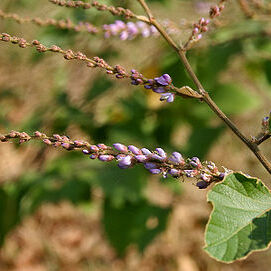Subshrub or woody herb, 0.5-3 m tall. Stems densely covered with short spreading pale ferruginous hairs when young, purplish-brown and glabrescent beneath. Leaves 1-foliolate; leaflet 2.5-19 x 1.1-13 cm, ovate, oblong-ovate or almost round, bluntly acute to very rounded at the apex, broadly cuneate, truncate or subcordate at the base, densely rather roughly appressed pubescent above, velvety beneath; petiole 2-22 mm long; petiolule 1.5-3.5 mm long; stipules linear from a broad base, 5-8 x 0.5-3 mm above, 2-3.5 mm wide at the base. Inflorescences pseudoracemose, terminal and axillary, 2-30 cm long, densely covered with uncinulate hairs; peduncles short, 5-25 mm long; pedicels 1.5-3 mm long; primary bracts 1.5-4 x 0.5-1 mm, lanceolate, each supporting 3-5 flowers; secondary bracts 1-1.5 mm long, linear, persistent. Calyx spreading-hairy; tube 1 mm long; lobes 0.7-1.5 mm long. Standard violet, lilac, red or blue, 4-5 x 4-5 mm, obovate; wings and keel darker mauve. Fruits 12-24 mm long, of 2-7 articles; each article 2.5-4 x 2.5-3.5 mm, densely covered with hooked hairs, joined by necks 1.5-2 mm wide. Seeds brown, 2.5 x 1.8 x 0.9 mm, ellipsoid-reniform; hilum small, central.
Shrubs or subshrubs, to 150 cm tall. Young branches densely yellow-brown velutinous and shortly hooked hairy. Leaves 1-foliolate, rarely intermixed with 3-foliolate leaves; petiole 1.5-1.8 cm, densely yellow velutinous; blade ovate, ovate-lanceolate, triangular-ovate, or broadly ovate, 4-17 × 2.5-11.5 cm, both surfaces yellow velutinous, indumentum denser and longer abaxially. Inflorescences terminal and axillary, racemose or paniculate, 4-10 cm, terminal ones often broadly paniculate, to 20 cm, 2-5-flowered at each node; bracts subulate or lanceolate, 2.5-12 × 0.3-0.7 mm. Pedicel ca. 1.5 mm. Calyx 2-3 mm, 4-lobed. Corolla purple or pink, 3-5 mm; standard obovate-orbicular; wings narrowly elliptic, auriculate; keel narrow, not auriculate. Legume narrowly oblong, 1-2 cm × 2-3 mm, lower suture incised between seeds, upper suture nearly straight, with dense yellow straight hairs intermixed with short hooked hairs, 5-7-jointed. Fl. and fr. Aug-Nov. 2n = 22.
A woody shrub. It grows from 0.5-2 m high. The stems are densely covered with pale hairs when young. The leaves normally have one leaflet but occasionally 3. The leaflet is 2.5-19 cm long by 1.1-13 cm wide. It is bluntly rounded at the tip. There a hairs which are more rough on top and velvety underneath. The flowers are 5 mm long in clusters either at the ends of branches or in the axils of leaves. These flower clusters are 2-30 cm long. They are covered with hooked hairs. The flowers are mauve, red or blue. The fruit are pods 1.2-2.4 cm long and with 2-7 segments.
Leaves 1-foliolate; leaflet 2.5–19 × 1.1–13 cm, ovate, oblong-ovate or almost round, bluntly acute to very rounded at the apex, broadly cuneate, truncate or subcordate at the base, densely rather roughly appressed pubescent above, velvety beneath; petiole 2–22 mm long; petiolule 1.5–3.5 mm long; stipules linear from a broad base, 5–8 × 0.5–3 mm above, 2–3.5 mm wide at the base.
Inflorescences pseudoracemose, terminal and axillary, 2–30 cm long, densely covered with uncinulate hairs; peduncles short, 5–25 mm long; pedicels 1.5–3 mm long; primary bracts 1.5–4 × 0.5–1 mm, lanceolate, each supporting 3–5 flowers; secondary bracts 1–1.5 mm long, linear, persistent.
Fruits 12–24 mm long, of 2–7 articles; each article 2.5–4 × 2.5–3.5 mm, densely covered with hooked hairs, joined by necks 1.5–2 mm wide.
Stems densely covered with short spreading pale ferruginous hairs when young, purplish-brown and glabrescent beneath.
Standard violet, lilac, red or blue, 4–5 × 4–5 mm, obovate; wings and keel darker mauve.
Seeds brown, 2.5 × 1.8 × 0.9 mm, ellipsoid-reniform; hilum small, central.
Calyx spreading-hairy; tube 1 mm long; lobes 0.7–1.5 mm long.
A half-woody, erect, rather hairy undershrub, 3–6 ft. high
Fruit-segments which adhere like burrs.
Subshrub or woody herb, 0.5–3 m tall.
Small pink or purplish flowers

